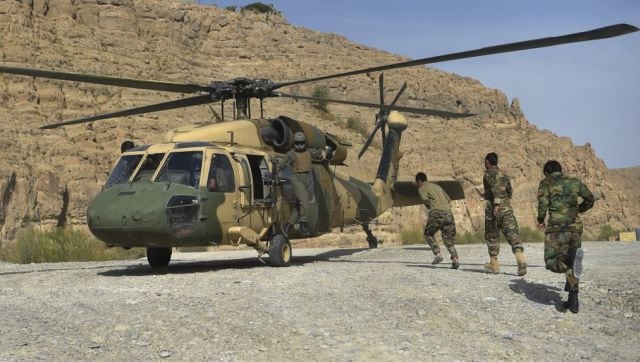So who won the Afghanistan war? America’s boots on the ground didn’t but it’s the suits who made a killing
[ad_1]
After 20 years and trillions of dollars gushing into the Afghanistan war and rebuilding effort, it’s the private military contractors that have come out on top, laughing their way to the bank
Afghan National Army soldiers unload items from a Black Hawk helicopter in Helmand Province, Afghanistan.
AFP
The Taliban’s stunning takeover of Afghanistan in the aftermath of a bungling United States departure has led many to conclude the war in Afghanistan ended in failure, with the US losing out not only in terms of its soldiers killed but also the massive spend on the war and reconstruction effort.
According to a Brown University calculation, the US spent $2.26 trillion in Afghanistan, or $300 million a day. Roughly $800 billion was funneled into direct war-fighting costs and $85 billion to train the now vanquished Afghan army. America has spent more on trying to keep the Taliban at bay than the net worth of Jeff Bezos, Elon Musk, Bill Gates and the 30 richest billionaires in America put together.
Brown University also projects that the cost of interest on the United States’ Afghan war debt will go up to $6.5 trillion by 2050. And that will pinch the average American since that translates to $20,000 for each and every US citizen.
The opposite is true for US armament manufactures and defence contractors who have come out of the ‘Long War’ as victors.
The war effort in Afghanistan was in many ways a privatised endeavour, with the US military relying on private security contractors to power the logistics of America’s “forever war”.
According to a report in The Intercept, the top five US defence contractors — Boeing, Raytheon, Lockheed Martin, General Dynamics and Northrop Grumman — the 20-year Afghanistan war was an “extraordinary success”.
If you had invested an evenly divided $10,000 in those companies’ stocks on 18 September, 2001, the date then-president George W Bush signed the Authorization for the Use of Military Force, those shares would be worth $97,795 today.
Here’s how these contractors went bigger from the war, spelt out in terms of $10,000 invested in 2001:
Boeing
If one had invested $10,000 in Boeing stock back in 2001, that would be worth $107,588.47 today. Boeing makes most of its money from commercial airliners but its big-ticket defence contracts relate to the B-1 bomber, B-52s, C-17 cargo jet, V-22 Osprey vertical takeoff aircraft, and F-15 and F-18 fighters.
Raytheon
The third-largest defence contractor in the world, Raytheon’s Long War stock return would be $43,166.92. The money earned isn’t only on weaponry being sold, but also on training contracts. For instance, Raytheon Intelligence and Space, a business of Raytheon Technologies, earned up to $145 million in 2020 when it signed a contract with the US military to train Afghanistan Air Force pilots.
Lockheed Martin
Ten thousand dollars in this company’s stock is now valued at $133,559.21. Known as the world’s biggest defence contractor, Lockheed is known for its Black Hawk helicopters, which have widely been used in the Afghan war. The big bucks for the company has come from contracts for the F-35 stealth fighter ($12 billion in the current budget alone).
General Dynamics
A total Long War return on General Dynamics is 625.37 percent, at $72,515.58. For General Dynamics, the Afghan war was particularly profitable as the Marines’ LAV-25 light armoured vehicle was widely used. Additionally, GD has also provided communications, IT, and cyber security products and services.
Northrop Gruman Corp
The 1939 company has made a total return of 1,196.14 per cent, at $129,644.84. In 2019, Stockholm International Peace Research Institute released data showing that it had notched up $29.22 billion.
Corporate interests
Defence contractors haven’t been the only winners of the Afghan war. Big corporations such as DynCorp International, KBR and Fluor Corporation have also made out like kings.
In the case of DynCorp International, a Daily Beast report stated that the State Department had paid $2.5 billion on projects such as training and equipping the Afghan police force. And that was DynCorp’s primary focus in Afghanistan, too — although the firm also handled jobs like providing bodyguards for Afghanistan president, Hamid Karzai.
The US Department of Defense has spent $3.8 billion for Fluor’s work in Afghanistan since 2015, federal records show, most of it for logistics services.
In addition, oil companies like ExxonMobil which shipped the fuel on which the army runs — are just some to have profited immensely from Washington’s lucrative contracts.
As retired Air Force lieutenant colonel Karen Kwiatkowski said in the 2005 documentary Why We Fight: “American people who have a son or a daughter that’s going to be deployed… they look at the cost-benefit, and they go ‘I don’t think that’s good.’ But when politicians who understand contracts, future contracts, when they look at war, they have a different cost-benefit analysis.”
[ad_2]
Source link


Comments are closed.